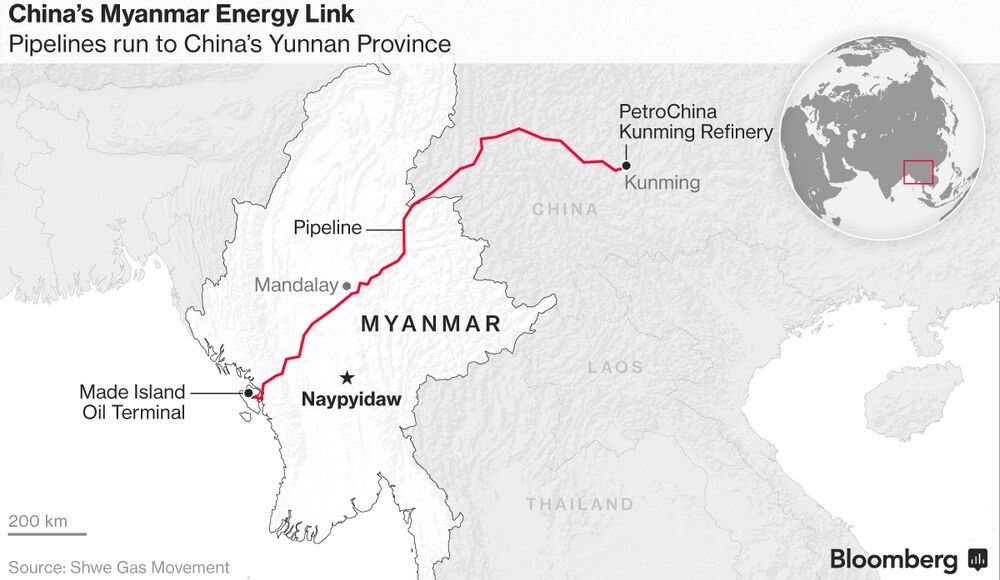Hendrik_2000
Lieutenant General
So both gas and oil pipeline is now operating. Notice the sourgrape comment by this author Ofcourse it benefit China but once the oil flowed Myanmar will get steady stream of income to fund their economy growth
Parallel to the oil pipeline of Maday, another link has been functioning since October last, from the sea port of Kyaukpyu, which is dedicated to methane. This pipeline has already transported to China four billion cubic meters of methane from both Burmese and Middle Eastern (Qatari) sources.
The $2.5 billion invested into the pipeline have been entirely covered by the giant state-owned oil company, China National Petroleum Company (CNPC), which owns this key infrastructure. But the project has not gained acceptance from all of the concerned parties. The Burmese locals have resented what they see as inadequate compensation for the expropriation of farmers affected by the building of the pipeline. They also resent the fact that almost all of these riches associated with the project are heading to China through their territory, depriving Myanmar of any gains from this potentially valuable development tool. Others lament the limited effort to protect the environment during the pipeline’s construction. But all of these hard feelings disappeared once China promised to hand over a total of 53 billion dollars in royalties in 30 years to the government of Myanmar. And the local Myanmar armed factions were pacified by $25 million in schooling and other social development projects. Some 10% of the gas is supposed to stay in Burma, but none of the oil, as the refining facility will be built in Kunming, at the end of the line, with a capacity of 10 million of tons of crude oil.

The project is concluded, but this does not mean that the local Burmese opinion is happy about such Chinese infrastructure building or about Myanmar’s collaboration on such undertakings with its giant neighbour? Accusations of resource plundering are still rife. In 2011, another giant Chinese project was temporarily put on ice for now by massive social protests. That project was the huge Myitsone dam, whose power output (100 billion of KW/h per year) was to go entirely Yunnan. Its fate is not yet entirely decided, but in a hint of things to come, up to 45.000 villagers have been relocated.
Another even bigger behemoth project is now in the works, a railway line is being discussed, which will follow the route taken by the pipelines. This project has a price tag of $20 billion dollars and would allow China to more easily import Burma’s precious wood and all sorts of other commodities, while also facilitating the flow of Chinese workers to the coast. As of now, no decision has been taken, but given Beijing’s leverage, the construction of the new railroad seems to be foregone conclusion.
Parallel to the oil pipeline of Maday, another link has been functioning since October last, from the sea port of Kyaukpyu, which is dedicated to methane. This pipeline has already transported to China four billion cubic meters of methane from both Burmese and Middle Eastern (Qatari) sources.
The $2.5 billion invested into the pipeline have been entirely covered by the giant state-owned oil company, China National Petroleum Company (CNPC), which owns this key infrastructure. But the project has not gained acceptance from all of the concerned parties. The Burmese locals have resented what they see as inadequate compensation for the expropriation of farmers affected by the building of the pipeline. They also resent the fact that almost all of these riches associated with the project are heading to China through their territory, depriving Myanmar of any gains from this potentially valuable development tool. Others lament the limited effort to protect the environment during the pipeline’s construction. But all of these hard feelings disappeared once China promised to hand over a total of 53 billion dollars in royalties in 30 years to the government of Myanmar. And the local Myanmar armed factions were pacified by $25 million in schooling and other social development projects. Some 10% of the gas is supposed to stay in Burma, but none of the oil, as the refining facility will be built in Kunming, at the end of the line, with a capacity of 10 million of tons of crude oil.

The project is concluded, but this does not mean that the local Burmese opinion is happy about such Chinese infrastructure building or about Myanmar’s collaboration on such undertakings with its giant neighbour? Accusations of resource plundering are still rife. In 2011, another giant Chinese project was temporarily put on ice for now by massive social protests. That project was the huge Myitsone dam, whose power output (100 billion of KW/h per year) was to go entirely Yunnan. Its fate is not yet entirely decided, but in a hint of things to come, up to 45.000 villagers have been relocated.
Another even bigger behemoth project is now in the works, a railway line is being discussed, which will follow the route taken by the pipelines. This project has a price tag of $20 billion dollars and would allow China to more easily import Burma’s precious wood and all sorts of other commodities, while also facilitating the flow of Chinese workers to the coast. As of now, no decision has been taken, but given Beijing’s leverage, the construction of the new railroad seems to be foregone conclusion.







